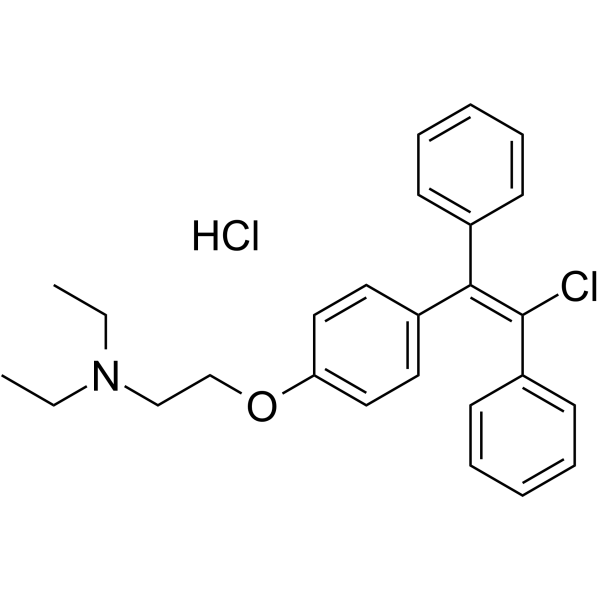14158-65-7
| Name | trans-Clomiphene Hydrochloride |
|---|---|
| Synonyms |
Enclomiphene hydrochloride
2-[4-[(E)-2-chloro-1,2-diphenylethenyl]phenoxy]-N,N-diethylethanamine,hydrochloride |
| Description | Enclomiphene ((E)-Clomiphene) hydrochloride is a potent and orally active non-steroidal estrogen receptor antagonist, with antioestrogenic property. Enclomiphene hydrochloride can be used for the research of ovarian dysfunction, testosterone deficiency, male hypogonadism and type 2 diabetes[1]. |
|---|---|
| Related Catalog | |
| In Vitro | Enclomiphene hydrochloride (0-100 μM, 6 h) dose-dependently inhibits basal and gonadotrophin-stimulated small and large ovine luteal cell progesterone secretion[2]. Enclomiphene hydrochloride (0-100 μg/mL, 24 h) dose-dependently inhibits fertilization rates, blastocyst formation rates, and degeneration rates in mouse oocytes[3]. Enclomiphene hydrochloride (1 nM-10 μM, 6 h) dose-dependently decreases E2-induced inhibition of follicle stimulating hormone (FSH) secretion in primary sheep pituitary cells[4]. |
| In Vivo | Enclomiphene hydrochloride (subcutaneous injection, 0.25 and 0.5 mg/animal, daily) inhibits spermatogenesis and decreases serum luteinizing hormone (LH) and testosterone levels in intact or castrated rats[5]. Enclomiphene hydrochloride (oral adminstration, 0.03-3 mg/kg, daily for 90 days) reductes body weight to sham levels, and reduced serum cholesterol[6]. Animal Model: 21 days-old Charles River male rats[5] Dosage: 0.25 and 0.5 mg/animal, daily for 24 days. Administration: Subcutaneous injection Result: Decreased LH and testosterone levels in the serum. Animal Model: OVX (ovariectomy) rat model[6] Dosage: 0.03, 1, and 3 mg/kg, daily for 90 days. Administration: Oral adminstration Result: Reducted body weight to sham levels, and reduced serum cholesterol. Showed dose-dependent effects on the proximal tibia with BMD and BMC approaching posttreatment Sham levels. |
| References |
| Molecular Formula | C26H29Cl2NO |
|---|---|
| Molecular Weight | 442.42100 |
| Exact Mass | 441.16300 |
| PSA | 12.47000 |
| LogP | 7.36460 |
| RIDADR | NONH for all modes of transport |
|---|
